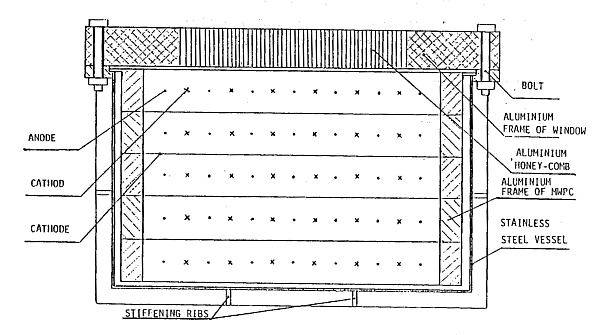Purpose of the flight and payload description
Objective of the mission was to test in flight a prototype of a balloon-borne hard X-ray spectroscope, developed as an initial step toward creating a larger telescope with both extensive sensitive area and superior energy resolution. The instrument was developed through a cooperation between the Institute of High Energy Physics (IHEP), Academia Sinica and the Physics Department of the Zhengzhou University.
The core of the instrument, which can be seen in the scheme at left (click to enlarge) was a multiwire proportional chamber filled with high-pressure Xenon gas, optimized to provide enhanced energy resolution and background noise rejection compared to traditional scintillation detectors. The entire detector structure was housed within a pressure vessel constructed from 4 mm thick stainless steel sheets, welded into a rectangular form and internally supported with ribs. This vessel featured two main compartments: one for the wire array (440 mm x 250 mm x 155 mm) and the other for the electronics (200 mm x 250 mm x 115 mm).
At the top of the vessel was located a composite window made of two 0.5 mm carbon fiber sheets sandwiching an aluminum honeycomb for structural strength. To prevent chemical reactions with Xenon gas, the lower face of the window was shielded with a 200-micron aluminum sheet. Above this window sat a brass collimator, which defined a field of view of 4 degrees full width at half maximum (FWHM).
Internally, the chamber was divided into five 30 mm thick detection layers using six cathode planes made of 100-micron gold-coated tungsten wires arranged 2 mm apart and tensioned to 100 grams. Between each pair of cathode planes were seven anode wires, also gold-coated tungsten but thinner at 20 microns and tensioned to 55 grams. These were fixed using crushed copper tubes and were separated by additional cathode wires, effectively dividing each layer into seven independent detection cells, each measuring 30 mm x 30 mm x 350 mm. The unit was rigidly mounted inside the vessel, and a combination of 2 mm tin and 1 mm lead shielding was applied to all sides and the bottom to reduce background radiation.
To prepare the chamber for operation, it underwent multiple evacuation and gas-filling cycles over a week to ensure minimal impurity. Ultimately, the detector was filled with a 3-atmosphere gas mixture consisting of 95% Xenon and 5% CH4, both purified to 99.999% using a zirconium-aluminum getter heated to 750°C. The detector's internal components were carefully selected from materials like stainless steel, aluminum, Teflon, ceramics, and gold-plated tungsten to avoid outgassing; adhesives were entirely avoided.
The energy resolution was notably good: 10% at 59.5 keV and 19% at 29.8 keV for single anode operation, slightly less precise when all anodes were connected together. This performance was further enhanced by the use of the "escape gating" technique, which leveraged Xenon's high K-fluorescence yield to improve resolution and reduce background. In this technique, only events accompanied by simultaneous detection of a K-fluorescent photon were deemed valid, simplifying spectrum deconvolution and eliminating the need for corrections due to escape peaks.
Escape gating electronics were organized into five anode groups, each linked to its own preamplifier and linear amplifier, with discriminator circuits to filter valid K-fluorescence signals. One group served a veto function to suppress unrelated events. The data acquisition system used a Z80 microprocessor interfaced through an STD bus, digitizing signals, compiling energy spectra in 256 channels, and transmitting data via a pulse-code modulated telemetry system to ground stations for real-time monitoring and storage.
Details of the balloon flight
Balloon launched on: 8/31/1987
Launch site: Xiang He Balloon Launch Center, Hebei, China
Balloon launched by: Institute of High Energy Physics (IHEP)
Balloon manufacturer/size/composition: Zero Pressure Balloon 120.000 m3
End of flight (L for landing time, W for last contact, otherwise termination time): 8/31/1987
The balloon was launched on August 31, 1987 from the IHEP balloon flight facility in Xianghe, Hebei Province, China. The balloon ascended to a floating altitude of 37 kilometers above sea level.
During the flight, all onboard systems functioned as intended. The detector, stabilized at high altitude, began collecting hard X-ray data within its defined field of view. The target of the observation was Cyg X-1, a well-known black hole candidate. The balloon remained aloft for a duration long enough to gather sufficient data from this celestial source, contributing to the study of high-energy astrophysical processes.
The escape-gating mechanism performed effectively, allowing the spectroscope to filter out background events and focus on detecting meaningful signals associated with incoming hard X-rays. The observation setup enabled the extraction of cleaner and more accurate energy spectra, as only events accompanied by a K-fluorescence photon were processed. The onboard microprocessor continuously monitored the data, converted analog signals into digital spectra, and transmitted these packets to ground control. There, the data were decoded, recorded on diskettes, and selected monitoring parameters were displayed for immediate review.
The detector was safely recovered the following day. The gas inside, which had retained its purity during the mission thanks to stringent preparation protocols and material selection, was recollected using liquid nitrogen for future reuse. The overall success of the flight demonstrated the instrument's capability for real-world applications in X-ray astronomy and validated the escape gating approach. Following the flight, data analysis commenced, and the team began planning a more advanced version of the spectroscope, aiming for a larger sensitive area of 5000 cm² and enhanced performance to support further astrophysical observations.
The launch marked a significant milestone for the Chinese high-energy astrophysics research community, representing a practical test of advanced instrumentation in near-space conditions.
External references
- A balloon borne hard X-Ray spectroscope Report BIHEP-CR-88-02
12872If you consider this website interesting or useful, you can help me to keep it up and running with a small donation to cover the operational costs. Just the equivalent of the price of a cup of coffee helps a lot.


